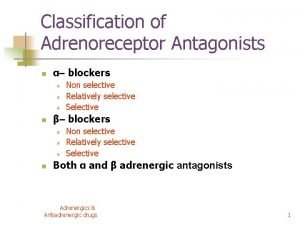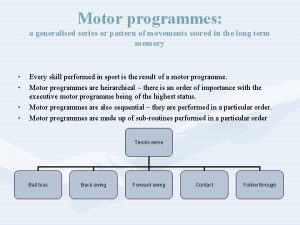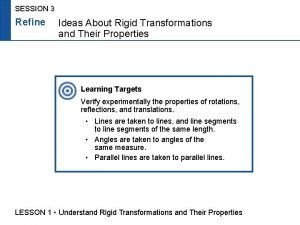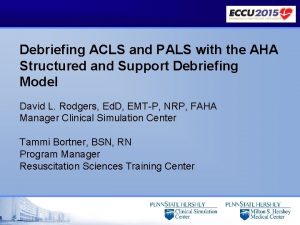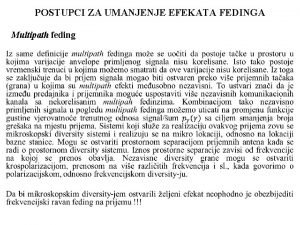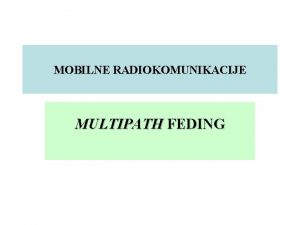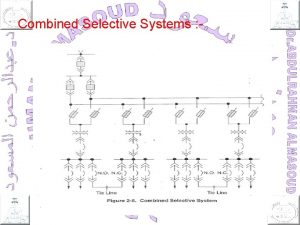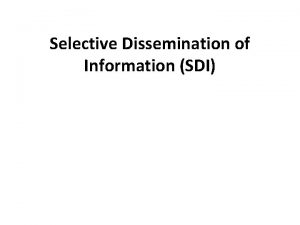SELECTIVE FEDING PROGRAMMES SESSION 20 1 SELECTIVE FEDING


































- Slides: 34

SELECTIVE FEDING PROGRAMMES SESSION 20 1

SELECTIVE FEDING PROGRAMME • There are two mechanisms through which food may be provided – General Food Distribution – Selective Feeding Programmes 2

SELECTIVE FEEDING PROGRAMMES • The GFR, in pracctice, rarely provides sufficient food to allow for catch-up weight gain for those already malnourished • SPFs are therefore a “safety net” for those whose families cannot cope and are not sustained by the general ration • SFP do not usually reduce the prevalence of moderate malnutrition • The main objective is to reduce the prevalence of severe malnutrition and mortality. 3

SELECTIVE FEEDING PROGRAMMES There are two forms of selective feeding programmes: • Supplementary Feeding • Therapeutic Feeding Programmes 4

SUPPLEMENTARY FEEDING PROGRAMMES Supplementary feeding programmes (SFPs) • Provide nutritious food in addition to the general ration • Supplementary Feeding Programmes (SFPs) • They aim to rehabilitate malnourished persons or to prevent a deterioration of nutritional status • SFPs are short-term measures and should not be seen as a means of compensating for 5 an inadequate general food ration.

SUPPLEMENTARY FEEDING PROGRAMMES Target Population • Children <5 years, Pregnant women, Lactating women up to six months, those suffering from chronic wasting illnesses. SFPs comprise two different types: • Targeted SFPs: the aim is to prevent the moderately malnourished becoming severely malnourished and to rehabilitate them. 6

Supplementary Feeding Programmes • Blanket feeding programmes: Aim is to prevent widespread malnutrition and to reduce excess mortality among those at-risk by providing a food/micronutrient supplement for all members of the group • Supplementary food can be distributed – On-site feeding – Take home or dry ration 7

SUPPLEMENTARY FEEDING PROGRAMMES Take-home rations: • Require less resources • Carries less risk of cross-infection • Takes less time to establish • Less time consuming for mother to attend • Responsibility for feeding within the family • Particularly appropriate for dispersed populations who have had to travel long distances on a daily basis 8

SUPPLEMENTARY FEEDING PROGRAMMES On-site feeding me be justified: • Food supply in the household is limited • Firewood and cooking utensils are in short supply • Security situation is poor and beneficiaries are at-risk when returning home carrying weekly supplies of food 9

TARGETED SUPPLEMENTARY FEEDING PROGRAMMES Objective • Rehabilitate moderately malnourished persons • Prevent the moderately malnourished from becoming severely malnourished • Reduce mortality and morbidity risk in children under 5 years • Provide a food supplement to selected pregnant and nursing mothers and other individuals at-risk • Provide follow-up to referrals from Therapeutic Feeding Programmes 10

TARGETED SUPPLEMENTARY FEEDING PROGRAMMES When to start • Malnutrition prevalence of 10 -14% global acute malnutrition among children • Many malnourished individuals due to poor food security and high rates of disease and prevalence of 5 -9% global acute malnutrition in the presence of aggravating factors 11

TARGETED SUPPLEMENTARY FEEDING PROGRAMMES • Moderately malnourished children under five years of age Ø Between 70% and 80% if the median weight for height OR Ø Between – 3 and – 2 Z weight-for-height Ø Malnourished individuals (based on weight-forheight, BM 1, MUAC) or clinical signs: • • Older children 5 -10 year Adolescents Adults and the elderly persons Medical referrals 12

TARGETED SUPPLEMENTARY FEEDING PROGRAMMES Criteria for admission cont. • Referrals from TFC • Selected pregnant women and nursing mothers until 6 months, using MUAC <22 cm 13

TARGETED SUPPLEMENTARY FEEDING PROGRAMMES Criteria for discharge: • Children who have maintained at least 85% of medium weight-for-height for a period of two weeks (wet SFP) or one month (dry SFP) • Individuals older than 5 years who have attained a stable and satisfactory nutritional status and who are free from disease 14

TARGETED SUPPLEMENTARY FEEDING PROGRAMMES When to close? • When all the following criteria are safisfied • General food distribution is adequate (meeting planned nutritional requirement) • Prevalence of acute malnutrition is below 10% without aggravating factors • Control measures for infectious diseases are effective • Deterioration in nutritional situation is not anticipated 15

TARGETED SUPPLEMENTARY FEEDING PROGRAMMES Criteria for closing cont. • In cases where the prevalence of acute malnutrition is below 5% (in the presence of aggravating factors) but the absolute number of malnourished children may still be considerable, the closure of TSFPs may not be appropriate 16

BLANKET SUPPLEMENTARY FEEDING PROGRAMMES Objective: • Aimed primarily to prevent deterioration in the nutritional status of the population, but also reduce the prevalence of acute malnutrition in children under five years thereby reducing mortality and morbidity 17

BLANKET SUPPLEMENTARY FEEDING PROGRAMMES • No need when there is an adequate general ratio • Necessary when nutritional needs are not met by the general ration or other ways 18

BLANKET SUPPLEMENTARY FEEDING PROGRAMMES When to set up Blanket SFPs: • At the onset of an emergency when the GFR distribution systems are not adequately in place • Problems in delivering/distributing the GFR • Prevalence of 10 -14% acute malnutrition in presence of aggravating factors • To provide micronutrient-rich food to the target population in times of deficiency outbreaks 19

BLANKET SUPPLEMENTARY FEEDING PROGRAMMES Criteria for admission • All children younger than 5 or 3 years using the height as a cut-off point (5 years=110 cm, 3 years=90 cm) • Pregnant women from the time of confirmed pregnancy, and nursing mothers until maximum 6 months after delivery • Other at-risk groups (for instance sick and elderly persons) 20

BLANKET SUPPLEMENTARY FEEDING PROGRAMMES When to close • General food distribution is adequate and is meeting planned minimum nutritional requirements • Prevalence of acute malnutrition is below 15% without aggravating factors • Prevalence of acute malnutrition is below 10% in presence of aggravating factors • Disease control measures are effective 21

FOOD COMMODITIES USED IN SFPs 1. The size and the type of daily food supplement will depend on the adequacy of GFR, the malnutrition rate and the feeding programme modalities 2. Food must be energy-dense and rich in micronutrients, culturally appropriate, easily digestible and palatable eg Corn Soya Blend (CSB), Unimix, Famix 3. In situations when cooking may not be feasible, ready to eat items, such as high-energy biscuits or locally made snacks, can be used. 22

FOOD COMMODITIES USED IN SFPs 4. Energy-dense foods that contain at least 100 kcal per 100 g with at least 30% of the energy coming from fat. Unimix, Famix, CSB have a fat content of only 6% and thus about 10 g of oil should be added to 100 g blended food during preparation, and be distributed as a dry pre-mix or cooked porridge 5. No use of fresh milk or milk powder in a takehome ration because it discourages breastfeeding and the danger bacterial contamination. Mix powdered milk with cereal flour and suga 23

FOOD COMMODITIES USES IN SFPs 6. On-site feeding or wet ration should provide from 500 to 700 kcals of energy person per day, including 15 to 25 g or protein 7. Take-home or dry ration should provide from 1, 000 to 1, 200 kcal person per day and 35 to 45 protein 24

MONITORING AND EVALUATION OF SFPs Done through: • Nutrition surveys • Growth monitoring • Regular collection of feeding centre statisistics 25

MONITORING AND EVALUATION OF SFPs • Indicators: • Recovery rate acceptable >70% alarming <50% • Death rate acceptable <3 per month, alarming >10 • Defaulting <15%, alarming >30% 26

THERAPEUTIC FEEDING PROGRAMMES (TFPs) Objective: • To provide treatment to severely malnourished individuals to reduce the risk of excess mortality and morbidity • It consists of intensive medical and nutritional treatment 27

THERAPEUTIC FEEDING PROGRAMMES (TFPs) When to start? • When the number of severely malnourished individuals cannot be treated adequately in other facilities • The availability of trained staff is a prerequisite for establishing TFPs. 28

THERAPEUTIC FEEDING PROGRAMMES (TFPs) • Criteria for admission • Children younger than 5 years of age (or less than 110 cm in height) who are severely malnourished (weight-for-height less than – 3 z scores or less than 70% of the median and/or with oedema) • Severely malnourished children older than 5 years, adolescents and adults. Use of BM 1<16 • Low birth weight (LBW) babies • Orphans younger than one year (only when traditional care practices are inadequate) 29

THERAPEUTIC FEEDING PROGRAMMES (TFPs) Criteria for admission cont. • Mother of children younger than one year with breastfeeding failure • Criteria for discharge: Refer a child to SFP when he/she: • Maintains a weight-for-height>=75% of the reference of >=-2. 5 score for two consecutive weeks • Shows a good appetite and is free of illness 30

THERAPEUTIC FEEDING PROGRAMMES (TFPs) When to close: • Number of patients in decreasing (for e. g. drops below 20) • Adequate medical and nutritional treatment in either a clinic or a hospital is available 31

THERAPEUTIC FEEDING PROGRAMMES (TFPs) Nutritional Rehabilitation • Phase 1: Acute Phase (Intensive Care) • 24 -hour in-patient care • Control of infection and dehydration • Control of hypoglycaemia and hypthermia • Frequent feeds with TM (10 -12 times/day) • Only milk-based diets given • Diet contains 75 kcal/100 ml and is called F 75 32

THERAPEUTIC FEEDING PROGRAMMES (TFPs) • Phase 2: Rehabilitation Phase – – – Providing at least 6 meals per day to regain weight Medical care continues Mothers trained to care for the children at home Diet (F 100) is designed to for rapid catch-up in weight Cereal-based porridge, made of blended (fortified), oil and sugar is given – High-energy biscuits and gradual introduction to family diet 33

THERAPEUTIC FEEDING PROGRAMMES (TFPs) • • • Monitoring and Evaluation Recovery Rate, acceptable 75%, alarming <50% Death rate; acceptable <10, alarming >15 Defaulter; acceptable <15, alarming >25 Weight gain (g/kg/day); acceptable >=8, alarming<8 • Coverage; >50 -70%; alarming <40% • Mean length of stay; <3 -4 wks; >6 wks 34
 Labitolol
Labitolol Raymond marcillac et son chien
Raymond marcillac et son chien Fictional programmes
Fictional programmes Xcap gestion des programmes et dnc
Xcap gestion des programmes et dnc Eps niveau 3
Eps niveau 3 Marcus scheuren
Marcus scheuren Programme ce soir la tlvision
Programme ce soir la tlvision Designing brand marketing programs
Designing brand marketing programs Motor programmes
Motor programmes Agriseta skills programmes
Agriseta skills programmes Talent mobility programmes
Talent mobility programmes Vivre ensemble maternelle nouveaux programmes
Vivre ensemble maternelle nouveaux programmes Agriseta skills programmes
Agriseta skills programmes Mental health policy, plans and programmes michelle funk
Mental health policy, plans and programmes michelle funk Ifric13
Ifric13 Haccp prerequisites example
Haccp prerequisites example National health intervention programme for mother and child
National health intervention programme for mother and child 6 pillars of jesus youth in malayalam
6 pillars of jesus youth in malayalam Who guidelines on core components of ipc programmes
Who guidelines on core components of ipc programmes Public employment programmes
Public employment programmes Vertical health programmes
Vertical health programmes Session initialisation protocol
Session initialisation protocol Network configuration backup
Network configuration backup Understanding rigid transformations and their properties
Understanding rigid transformations and their properties Bgp culling
Bgp culling Function of session layer
Function of session layer Microsoft architecture design session
Microsoft architecture design session Harriet josephine terry
Harriet josephine terry Hkn review session
Hkn review session Fordham summer session
Fordham summer session Domain name system nedir
Domain name system nedir Intechange keys
Intechange keys Jad session interview questions
Jad session interview questions Practical session definition
Practical session definition Gas debriefing tool
Gas debriefing tool
